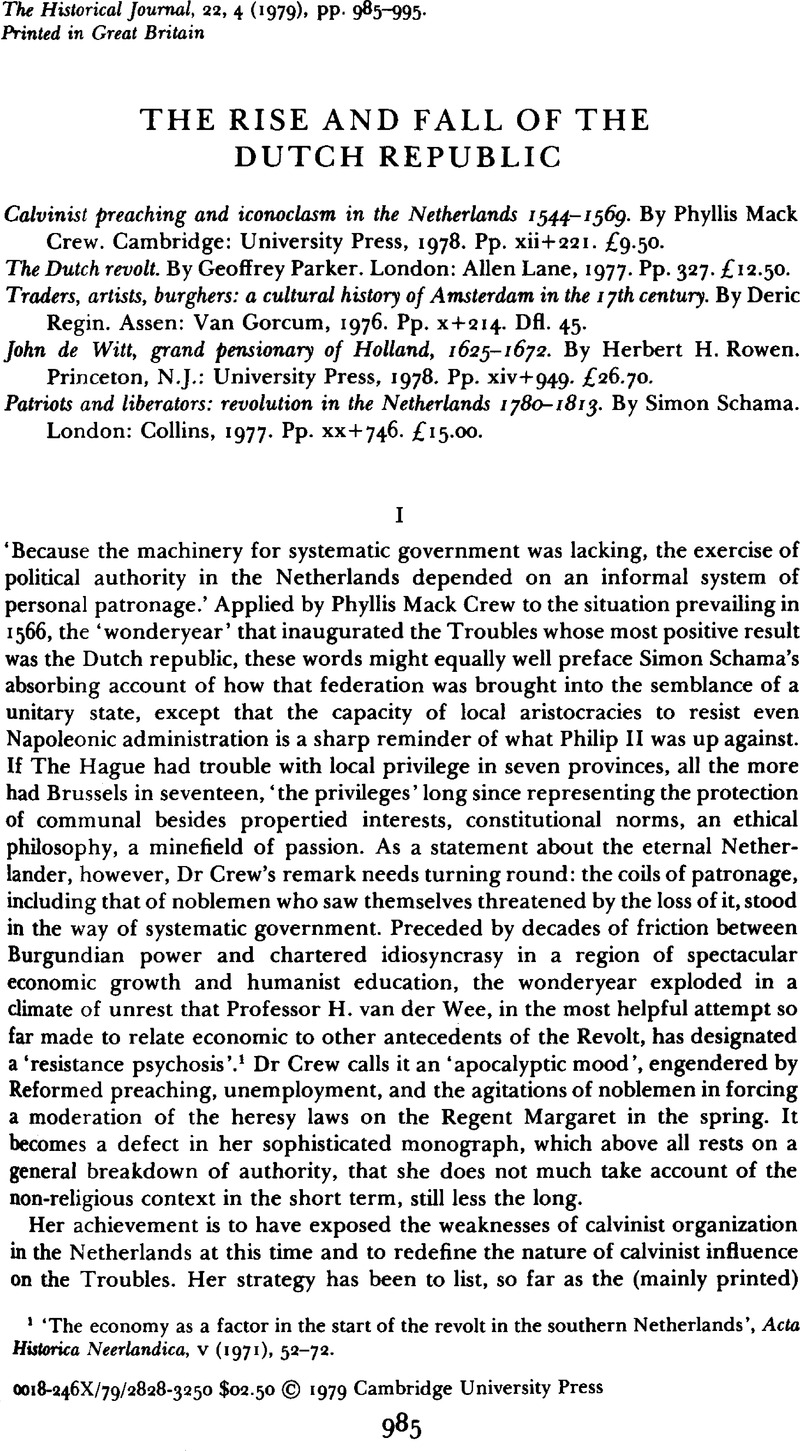Published online by Cambridge University Press: 11 February 2009

1 ‘The economy as a factor in the start of the revolt in the southern Netherlands’, Acta Historica Neerlandica, v (1971), 52–72Google Scholar.
2 There is some overlap between pre-and post-1566 activity, indicated by asterisks, whose significance is not however clarified until a footnote at the end of the appendixes.
3 I owe this observation and much else to Mr A. C. Duke of Southampton. Cf. Regnault, J. M. and Vermander, P., ‘La crise iconoclaste de 1566 dans la région d'Armentières’, Revue du Nord, LIX (1977), 221–31CrossRefGoogle Scholar.
4 The trumpet shall sound (2nd edn, London, 1957)Google Scholar.
5 Cf. Duke, A. C. and Kolff, D. H. A., ‘The time of troubles in the county of Holland, 1566–1567,’ Tijdschrift voor Geschiedenis, LXXXII (1969), 316–37Google Scholar.
6 Now collected as Spain and the Netherlands 1559–1659;ten studies (London, 1979: Collins, Fontana pbk. £2.50)Google Scholar.
7 Clark, G. N., ‘The birth of the Dutch republic,’ Proceedings of the British Academy, XXXII (1946), 189Google Scholar.
8 Kossmann, E. H. and Mellink, A. F. (eds.), Texts concerning the revolt of the Netherlands (Cambridge, 1974), 48Google Scholar. The introduction to this volume offers a perspicacious guide to the legal and philosophical aspects of the Revolt, somewhat neglected by Parker. Elizabeth intended much less by the governor-generalship than what Leicester and the States made of it.
9 William the Silent and the revolt of the Netherlands (London, Historical Association, gen. ser. 94, 1978)Google Scholar.
10 Particularly ‘Why did the Dutch revolt last eighty years?’, Transactions of the Royal Historical Society, 5th ser., XXVI (1976), 53–72Google Scholar; and ‘War and economic change: the economic costs of the Dutch revolt,’ in Winter, J. M. (ed.), War and economic development (Cambridge, 1975), pp. 49–71Google Scholar.
11 La vie quotidienne en Hollande au temps de Rembrandt (Paris, 1962 E.T. London, 1962)Google Scholar.
12 The Dutch nation: an historical study (London, 1944), p. 100Google Scholar.
13 Dutch civilization in the seventeenth century and other essays (London, 1968), pp. 9–10Google Scholar.
14 Ibid. p. 80.
15 Reprinted in Verzamelde Werken, II (Haarlem, 1948), 74–85.
16 Notably The ambassador prepares for war: the Dutch embassy of Arnauld de Pomponne, 1669–1671 (The Hague, 1957)Google Scholar.
17 Roorda, has provided a long summary of his thesis, Partij en factie (Groningen, 1961)Google Scholar in Acta Neer. Hist. 11 (1967), 188–221Google Scholar. Rowen fairly asserts (p. 140 n.) that we are a long way from understanding the socio-economic structure of political forces in the republic.
18 Rowen is indebted to Franken, M. A. M., ‘The general tendencies and structural aspects of the foreign policy and diplomacy of the Dutch republic in the latter half of the seventeenth century,’ Acta Neer. Hist, III (1968), 1–42Google Scholar; cf. idem, Coenraad van Beuningen's polilieke en diplomatieke aktiviteiten in de jaren 1667–1684 (Groningen, 1966)Google Scholar.
19 ‘Witt, John de and the Triple Alliance,’ Journal of Modern History, XXVI (1954), 1–14Google Scholar.
20 Boogman, J. C., ‘De raison-d'état-politicus Johan de Witt,’ Bijdragen en mededelingen betrejfende de geschiedenis der Nederlanden, XC (1975), 379–407Google Scholar.
21 ‘Democratische tendenties in 1672’, Mededelingen der Koninklijke Nederlandse Akademie van Wetenschappen, Afdeling Letterkunde, new ser., XIII, no. 11 (1950)Google Scholar.
22 De Lage Landen 1780–1940 (Amsterdam-Brussels, 1976), ch. 2Google Scholar; an English version of this important book is overdue from O.U.P.
23 And summarized, with fresh detail, in Duke, A. C. and Tamse, C. A. (eds.), Britain and the Netherlands, VI (The Hague, 1977), 94–123Google Scholar. This volume, subentitled ‘War and society’, contains two further contributions of some relevance: J. Aalbers, ‘Holland's financial problems (1713–1733) and the wars against Louis XIV, and Buist, M. G., ‘The sinews of war: the role of Dutch finance in European politics (c. 1750–1815)’ – a useful summary of Buist's thesis, At spes rum fracta: Hope & Co. 1770–1815 (The Hague, 1974)Google Scholar, which has escaped Dr Schama's net.